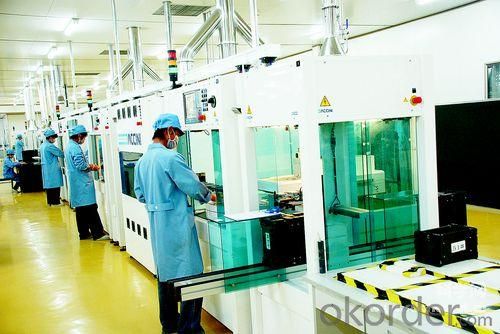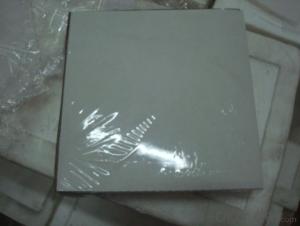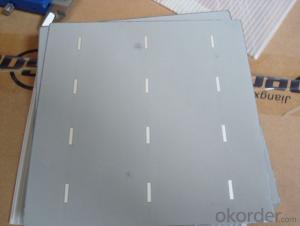Polycrystalline Solar Cells-Tire 1 Manufacturer -16.6%
- Loading Port:
- Shanghai
- Payment Terms:
- TT OR LC
- Min Order Qty:
- 10000 pc
- Supply Capability:
- 50000000 pc/month
OKorder Service Pledge
OKorder Financial Service
You Might Also Like
Brief Introduction of Solar Cells
A solar cell is a fabricated device that converts the sun’s light into electricity. If we want to get right into it, a solar cell takes the energy from the sun’s light rays, by using the colliding light at the photon level to split apart the electron-hole pairs. When the photon hits the pair, they break, and one part goes north one part south. The stronger the sun, the quicker and more this happens. This process is called the photoelectric effect. The following diagram explains.
Specifications of Polycrystalline Solar Cells
Format : 156 mm × 156 mm ± 0.5 mm
Thickness: 210 μm ±40 μm
Front (-) : 1.5mm bus bars (silver),blue anti-reflection coating (silicon nitride)
Back (+) : 2.5mm wide soldering pads (silver) back surface field (aluminium)
Efficiency (%) | Pmpp (W) | Umpp (V) | Impp (A) | Voc (V) | Isc (A) |
18.00% | 4.38 | 0.528 | 8.291 | 0.631 | 8.869 |
17.80% | 4.33 | 0.525 | 8.252 | 0.629 | 8.821 |
17.60% | 4.29 | 0.532 | 8.053 | 0.633 | 8.541 |
17.40% | 4.23 | 0.528 | 8.092 | 0.624 | 8.632 |
17.20% | 4.19 | 0.524 | 7.992 | 0.62 | 8.458 |
17.00% | 4.14 | 0.52 | 7.972 | 0.623 | 8.5 |
Advantage of Polycrystalline Solar Cells
High conversion efficiencies resulting in superior power output performance.
Suitable for keeping appearance of solar cell tidy and clean.
Advanced diffusion technology adapted to ensure conversion efficiency uniformity throughout cell.
Advanced PECVD film forming technology used to coat cells with dark blue silicon nitride anti-reflection coatings.
Uniform color appearance.
Advanced soft line and high precision silkscreen printing equipment to achieve high smoothness, make automatic welding and laser cutting easier.
Metal paste applied to making back surface field and electrode to ensure top conductivity, nice adhesion, superior weld-ability, nice appearance and reliable performance.
Efficiency, stability and durability of crystal silicon.
Low breakage rate.
Environmental protection.
OEM orders are welcome
Usage of Polycrystalline Solar Cells
Solar cells are often electrically connected and encapsulated as a module. Photovoltaic modules often have a sheet of glass on the front (sun up) side, allowing light to pass while protecting the semiconductor wafers from abrasion and impact due to wind-driven debris, rain, hail, etc. Solar cells are also usually connected in series in modules, creating an additive voltage. Connecting cells in parallel will yield a higher current; our solar cells have passed IEC Certification. With high and stable quality, our cells can greatly improve the performance of Solar Modules.
Applications of Polycrystalline Solar Cells
Assemblies of photovoltaic cells are used to make solar modules which generate electrical power from sunlight, as distinguished from a "solar module" or "solar panel". A solar array generates solar power using solar energy.
Packaging & Delivery of Polycrystalline Solar Cells
Carton Box Package and Deliver by air. It should be noticed that it should be avoid of water, sunshine and moist.
Factory Picture of Solar Cells



We have organized several common questions for our clients,may help you sincerely:
1. What’s price per watt?
A: It’s depends on the quantity, delivery date and payment terms of the order. We can talk further about the detail price issue. Our products is high quality with lower price level.
2. Can you tell me the parameter of your solar cells?
We have different series of cells with different power output, both from c-si to a-si. Please take our specification sheet for your reference.
3. How do you pack your products?
We have rich experience on how to pack the panels to make sure the safety on shipment when it arrives at the destination.
4. Can you do OEM for us?
Yes, we can.
5. How long can we receive the product after purchase?
In the purchase of product within three working days, We will arrange the factory delivery as soon as possible. The perfect time of receiving is related to the state and position of customers. Commonly 7 to 10 working days can be served.
- Q:What is the role of disconnect switches in solar cell systems?
- Disconnect switches in solar cell systems serve as a crucial safety measure by providing a means to isolate the solar panels from the electrical grid. They allow for the safe maintenance, repair, or replacement of solar components without the risk of electrical shock or damage. Additionally, disconnect switches enable efficient troubleshooting and troubleshooting of solar systems by allowing technicians to isolate specific sections of the system for inspection or repair.
- Q:What is the role of surge suppressors in solar cell systems?
- The role of surge suppressors in solar cell systems is to protect the system from voltage surges or spikes that can occur due to lightning strikes, grid faults, or other electrical disturbances. These suppressors help to regulate the voltage levels and prevent damage to the solar cells, inverters, and other components of the system.
- Q:Can solar cells be used in medical devices?
- Yes, solar cells can be used in medical devices. They can be integrated into various medical devices such as implantable devices (pacemakers), wearable devices (fitness trackers), and portable devices (blood glucose monitors) to provide a sustainable and reliable source of power.
- Q:What is the cost of producing a solar cell?
- The cost of producing a solar cell can vary depending on several factors such as the type and quality of materials used, the manufacturing process, and economies of scale. However, on average, the cost of producing a solar cell ranges from $0.20 to $0.70 per watt.
- Q:Can solar cells be used for powering schools?
- Yes, solar cells can be used for powering schools. Solar panels can be installed on rooftops or in open spaces near the school to capture sunlight and convert it into electricity. This renewable energy source can help meet the energy needs of schools, reducing their reliance on fossil fuels and lowering their carbon footprint. Additionally, solar power can provide a reliable and cost-effective source of electricity for schools, allowing them to save on energy expenses in the long run.
- Q:Can solar cells be used in desalination plants?
- Yes, solar cells can be used in desalination plants. Solar energy can be harnessed by solar cells to power the desalination process, making it a sustainable and environmentally friendly approach. The solar cells can generate electricity to run the desalination equipment, such as reverse osmosis systems, efficiently converting saltwater into freshwater.
- Q:Can solar cells be used in powering electric boats?
- Yes, solar cells can be used to power electric boats. Solar panels can convert sunlight into electricity, which can then be used to charge the batteries of electric boats. This renewable energy source is clean, sustainable, and can help reduce carbon emissions from boating activities.
- Q:Can solar cells be used in agricultural applications?
- Yes, solar cells can be used in agricultural applications. Solar panels can provide a renewable source of energy to power various agricultural processes such as irrigation systems, lighting, and ventilation in greenhouses, as well as powering electric fences and monitoring equipment in farms. Solar energy can help reduce reliance on fossil fuels and provide a sustainable and environmentally friendly solution for powering agricultural operations.
- Q:Can solar cells be used on mobile devices?
- Yes, solar cells can be used on mobile devices. In fact, there are already solar-powered chargers available that can be attached to mobile devices to harness solar energy and charge them on the go. These solar cells convert sunlight into electricity, providing a sustainable and eco-friendly source of power for mobile devices.
- Q:How do solar cells perform in areas with high levels of dust storms?
- Solar cells may experience reduced performance in areas with high levels of dust storms due to the accumulation of dust particles on their surface. These dust particles can block sunlight, reducing the amount of energy that can be converted into electricity. Regular cleaning and maintenance of the solar panels may be required to ensure optimal performance in such environments.
1. Manufacturer Overview |
|
|---|---|
| Location | |
| Year Established | |
| Annual Output Value | |
| Main Markets | |
| Company Certifications | |
2. Manufacturer Certificates |
|
|---|---|
| a) Certification Name | |
| Range | |
| Reference | |
| Validity Period | |
3. Manufacturer Capability |
|
|---|---|
| a)Trade Capacity | |
| Nearest Port | |
| Export Percentage | |
| No.of Employees in Trade Department | |
| Language Spoken: | |
| b)Factory Information | |
| Factory Size: | |
| No. of Production Lines | |
| Contract Manufacturing | |
| Product Price Range | |
Send your message to us
Polycrystalline Solar Cells-Tire 1 Manufacturer -16.6%
- Loading Port:
- Shanghai
- Payment Terms:
- TT OR LC
- Min Order Qty:
- 10000 pc
- Supply Capability:
- 50000000 pc/month
OKorder Service Pledge
OKorder Financial Service
Similar products
New products
Hot products
Hot Searches
Related keywords




























